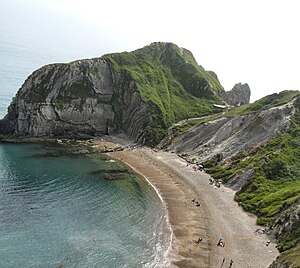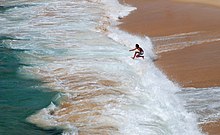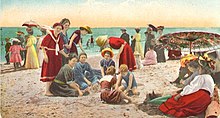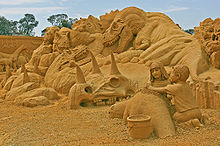A beach is a landform along the shoreline of an ocean, sea, lake or river. It usually consists of loose particles which are often composed ofrock, such as sand, gravel, shingle, pebbles or cobblestones. The particles comprising the beach are occasionally biological in origin, such asmollusc shells or coralline algae.
Wild beaches are beaches which do not have lifeguards or trappings of modernity nearby, such as resorts and hotels. They are sometimes called undeclared, undeveloped or undiscovered beaches. Wild beaches can be valued for their untouched beauty and preserved nature. They are most commonly found in less developed areas including, for example, parts of Puerto Rico, Thailand, the Philippines, and Indonesia.Bangladesh is the home of the world's longest natural sandy sea beach located at Cox's Bazar.
Beaches typically occur in areas along the coast where wave or current action deposits and reworks sediments.
Overview
Although the seashore is most commonly associated with the word beach, beaches are found by lakes and alongside large rivers, as well as by the sea or oceans.
Beach may refer to:
- small systems where rock material moves onshore, offshore, or alongshore by the forces of waves and currents; or
- geological units of considerable size.
The former are described in detail below; the larger geological units are discussed elsewhere under bars.
There are several conspicuous parts to a beach which relate to the processes that form and shape it. The part mostly above water (depending upon tide), and more or less actively influenced by the waves at some point in the tide, is termed the beach berm. The berm is the deposit of material comprising the active shoreline. The berm has a crest (top) and a face — the latter being the slope leading down towards the water from the crest. At the very bottom of the face, there may be a trough, and further seaward one or more long shore bars: slightly raised, underwater embankments formed where the waves first start to break.
The sand deposit may extend well inland from the berm crest, where there may be evidence of one or more older crests (the storm beach) resulting from very large storm waves and beyond the influence of the normal waves. At some point the influence of the waves (even storm waves) on the material comprising the beach stops, and if the particles are small enough (sand size or smaller) , winds shape the feature. Where wind is the force distributing the grains inland, the deposit behind the beach becomes a dune.
These geomorphic features compose what is called the beach profile. The beach profile changes seasonally due to the change in wave energy experienced during summer and winter months. The beach profile is higher during the summer due to the gentle wave action during this season. The lower energy waves deposit sediment on the beach berm and dune, adding to the beach profile. Conversely, the beach profile is lower in the winter due to the increased wave energy associated with storms. Higher energy waves erode sediment from the beach berm and dune, and deposit it off shore, forming longshore bars. The removal of sediment from the beach berm and dune decreases the beach profile.
The line between beach and dune is difficult to define in the field. Over any significant period of time, sand is always being exchanged between them. The drift line (the high point of material deposited by waves) is one potential demarcation. This would be the point at which significant wind movement of sand could occur, since the normal waves do not wet the sand beyond this area. However, the drift line is likely to move inland under assault by storm waves.
[edit]Beach formation
Beaches are the result of wave action by which waves or currents move sand or other loose sediments of which the beach is made as these particles are held in suspension. Alternatively, sand may be moved by saltation (a bouncing movement of large particles). Beach materials come from erosion of rocks offshore, as well as from headland erosion and slumping producing deposits of scree. Some of the whitest sand in the world, along Florida's Emerald Coast, comes from the erosion of quartz in the Appalachian Mountains. A coral reef offshore is a significant source of sand particles.
The shape of a beach depends on whether or not the waves are constructive or destructive, and whether the material is sand or shingle. Constructive waves move material up the beach while destructive waves move the material down the beach. On sandy beaches, the backwash of the waves removes material forming a gently sloping beach. On shingle beaches the swash is dissipated because the large particle size allows percolation, so the backwash is not very powerful, and the beach remains steep. Cusps and horns form where incoming waves divide, depositing sand as horns and scouring out sand to form cusps. This forms the uneven face on some sand shorelines.
Several beaches are claimed to be the "world's longest", including Cox's Bazar, Bangladesh (120 km unbroken), Praia do Cassino, Fraser Island beach, 90 Mile Beach in Australia (151 km) and 90 Mile Beach in New Zealand (88 km), Troia-Sines Beach (63 km) in Portugal and Long Beach, Washington (which is about 40 km).
[edit]Beaches as habitat
For more details on this topic, see Seashore wildlife.
A beach is an unstable environment which exposes plants and animals to changeable and potentially harsh conditions. Some small animals burrow into the sand and feed on material deposited by the waves. Crabs, insects and shorebirds feed on these beach dwellers. The endangered Piping Plover and sometern species rely on beaches for nesting. Sea turtles also lay their eggs on ocean beaches. Seagrasses and other beach plants grow on undisturbed areas of the beach and dunes.
Ocean beaches are habitats with organisms adapted to salt spray, tidal overwash, and shifting sands. Some of these organisms are found only on beaches. Examples of these beach organisms in the southeast US include plants like sea oats, sea rocket, beach elder, beach morning glory aka Ipomoea pes-caprae, and beach peanut, and animals such as mole crabs aka Hippoidea, coquina clams aka Donax, ghost crabs, and white beach tiger beetles.[1]
[edit]Beaches and recreation
Beaches can be popular on warm sunny days. In the Victorian era, many popular beach resorts were equipped with bathing machines because even the all-covering beachwear of the period was considered immodest. This social standard still prevails in many Muslim countries. At the other end of the spectrum are topfree beaches and nude beaches where clothing is optional or not allowed. In most countries social norms are significantly different on a beach in hot weather, compared to adjacent areas where similar behaviour might not be tolerated and might even be prosecuted.
Usually beach wear consists of a bikini, short shorts, and beach sandals for women. For men it is usually swim trunks and beach sandals.
In more than thirty countries in Europe, South Africa, New Zealand, Canada, Costa Rica, South America and the Caribbean, the best recreational beaches are awarded Blue Flag status, based on such criteria as water quality and safety provision. Subsequent loss of this status can have a severe effect on tourism revenues.
Due to intense use by the expanding human population, beaches are often dumping grounds for waste and litter, necessitating the use of beach cleaners and other cleanup projects. More significantly, many beaches are a discharge zone for untreated sewage in most underdeveloped countries; even in developed countries beach closure is an occasional circumstance due to sanitary sewer overflow. In these cases of marine discharge, waterborne disease from fecalpathogens and contamination of certain marine species is a frequent outcome.
[edit]Artificial beaches
Some beaches are artificial; they are either permanent or temporary (For examples see Monaco, Paris, Copenhagen, Rotterdam, Nottingham, Toronto, Hong Kong and Singapore, and Tianjin).
The soothing qualities of a beach and the pleasant environment offered to the beachgoer are replicated in artificial beaches, such as "beach style" pools with zero-depth entry and wave pools that recreate the natural waves pounding upon a beach. In a zero-depth entry pool, the bottom surface slopes gradually from above water down to depth. Another approach involves so-called urban beaches, a form of public park becoming common in large cities. Urban beaches attempt to mimic natural beaches with fountains that imitate surf and mask city noises, and in some cases can be used as a play park.
Beach nourishment involves pumping sand onto beaches to improve their health. Beach nourishment is common for major beach cities around the world; however the beaches that have been nourished can still appear quite natural and often many visitors are unaware of the works undertaken to support the health of the beach. Such beaches are often not recognized (by consumers) as artificial.
A concept of IENCE has been devised to describe investment into the capacity of natural environments. IENCE is Investment to Enhance the Natural Capacity of the Environment and includes things like beach nourishment of natural beaches to enhance recreational enjoyment and snow machines that extend ski seasons for areas with an existing snow economy developed upon a natural snowy mountain. As the name implies IENCE is not quite mainstream natural science as its goal is to artificially invest into an environment's capacity to support anthropogenic economic activity. An artificial reefdesigned to enhance wave quality for surfing is another example of IENCE. The Surfrider Foundation has debated the merits of artificial reefs with members torn between their desire to support natural coastal environments and opportunities to enhance the quality of surfing waves. Similar debates surround beach nourishment and snow cannon in sensitive environments.
Sand art is the practice of modelling sand into an artistic form, such as a sand brushing, sand sculpture, sandpainting, or sand bottles. A sand castleis a type of sand sculpture resembling a miniature building, often a castle.
The two basic building ingredients, sand and water, are available in abundance on a sandy beach, so most sand play takes place there, or in a sandpit. Tidal beaches generally have sand that limits height and structure because of the shape of the sand grains. Good sand sculpture sand is somewhat dirty, having silt and clay that helps lock the irregular shaped sand grains together.
Sand castles are typically made by children, simply for the fun of it, but there are also sand sculpture contests for adults that involve large, complex constructions.
Ukrainian talent contest winner, Kseniya Simonova, gained worldwide fame and became an online phenomenon with her sand painting which depicted World War II and how her family had been separated by the war
Sand art has progressed well beyond simple sand castles, such as this elaborate sand sculpting display in Australia
Construction
Sand grains will not stick together unless the sand is reasonably fine. While dry sand is loose, wet sand is adherent if the proper amounts of sand and water are used in the mixture. The reason for this is that water forms little ‘bridges’ between the grains of sand when it is damp due to the forces of surface tension.[1] However if too much water is added the water fills the spaces between the grains, breaking down the bridges and thus lowering the surface tension, resulting in the sand being able to flow more easily and the structure collapsing.[1] According to the BBC TV programme Coast, the ideal ratio is eight parts dry sand to one part water,[2] (though this may depend on the type of sand).
When the sand dries out or gets wet, the shape of a structure may change and "landslides" are common. Furthermore, the mixture of fine (mostly sharper) and coarse sand granules is very important to achieve good "sand construction" results. Fine granules which have been rounded by the natural influences ofseas, rivers or fluvials, in turn negatively influence the bonding between the individual granules as they more easily slide past each other. Research[3] is thus necessary to find the most suitable sand to achieve an optimal, landslide-free construction.
Shovels and buckets are the main construction tool used in creating sand castles and sand sculptures, although some people use only their hands. Water from the sea to mix with the sand can be brought to the building site with a bucket or other container. Sometimes other materials, such as pieces of wood, are added to reinforce structures.
Sand sculpting as an art form has become very popular in recent years especially in coastal beach areas. Hundreds of annual competitions are held all over the world. Techniques can be quite sophisticated, and record-breaking achievements have been noted in the Guinness World Records. Sometimes contests are staged as advertising or promotional events.
Some sandcastle artists are purists, using no artificial materials, formwork, coloring, adhesive or heavy machinery. One such purist is G. Augustine Lynas, who has been building public sand sculptures for over 50 years. However, in sand sculpting competitions, the rules often require that the finished sculpture be sprayed with a stabilizing coating that preserves it and allows the work to be properly judged and enjoyed by spectators. Coated sculptures can last for months.
[edit]Drip castles
A variant on the sandcastle is the drip castle, made by mixing the sand with water and dripping it from a fist held above. Some refer to the technique as "dribbling." When the slurry of sand and water lands on existing sand structures, the effect is Gaudi-esque.
[edit]Festivals and competitions
Main article: Sand festival
Since 1989, a World Championship in Sand Sculpture has been held in Harrison Hot Springs in Harrison, British Columbia, Canada, also known as "Harrisand". The competition has solo, double and team categories. The world's tallest sandcastle was built on Myrtle Beach in South Carolina as part of the 2007 Sun Fun Festival. The structure was 49.55 feet (15.1 m) high. It took 10 days to construct, and used 300 truckloads of sand.[4]
On September 1, 2007, Ed Jarrett completed his world-record 31.7-foot (9.66 m) high sand castle, at the Point Sebago Resort in Casco, Maine. The "Castle to the Sun" was constructed to raise funds to benefit sick children at Camp Sunshine on Sebago Lake. He created a 29-foot 3 inch (8.9 m) sand castle inFalmouth, Maine in 2003 declared the world's tallest.[5]
An annual competition is held on Siesta Key, Florida every year. Its fine, white quartz sand regularly wins comparison rankings of beach sand, yet complex structures are built during the competition.
[edit]Professional sand sculpting companies
In recent years many artists have formed companies specifically geared towards creating sand sculptures. These companies have found a niche market with corporate and private clients looking to promote a business or product or simply to wow their guests at a special event. While most of these businesses operate part time, there are a few that operate as full time businesses.
[edit]Other sand games
One of the main attractions of a sandy beach, especially for children, is playing with the sand, as it presents more possibilities than an ordinary sandbox.
One can make a mountain, a pit (encountering clay or the water table), canals, tunnels, bridges, a sculpture (representing a person, animal, etc., like a statue, or a scale model of a building), and many other things.
Tunnels large enough to enter are extremely hazardous; children have been killed when such underground chambers have collapsed under their own weight and instability, or due to the tide coming up or the structure being hit by a wave. Sometimes a dam can be built to hold back the water, or canals can be dug to contain the water.
Burying someone up to his/her neck in sand, or burying oneself, is another popular beach activity.














No comments:
Post a Comment